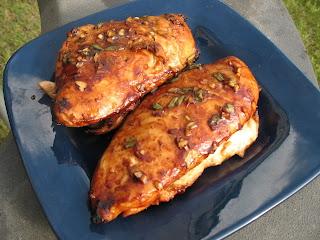 Each season has its fruits. In the late spring and early summer, there are strawberries and rhubarb. Autumn has apples, pears and cranberries. And right now the markets are full of stone fruits: peaches, nectarines, apricots, plums and cherries. All of these are excellent candidates for my favortie treatment for a season's fruits: fruit crisp.
Each season has its fruits. In the late spring and early summer, there are strawberries and rhubarb. Autumn has apples, pears and cranberries. And right now the markets are full of stone fruits: peaches, nectarines, apricots, plums and cherries. All of these are excellent candidates for my favortie treatment for a season's fruits: fruit crisp.Even more than pies and tarts, I like crisps. For one thing, they're easier to make. Just mix the fruit with sugar, a thickener such as flour or cornstarch, and perhaps an enhancing flavor like extract, citrus zest or warm spices like cinnamon, nutmeg and cloves. Then, you just toss together a topping of oats, flour, nuts and brown sugar, sprinkle it over the top and bake it. The most difficult part is waiting for the darn thing to cool enough to eat without blistering your tongue!
I've been trying to develop a basic recipe for fruit crisps that's just ready to go no matter what fruit is abundantly on hand. Most recently, it was piles of dark bing cherries and red plums. I couldn't help but keep buying cherries because their price was so good. And the plums were slightly soft when gently squeezed and smelled like, well, plums (something that's becoming rare in today's bullet-proof supermarket fruit).
For my streusel-like topping, I went with whole wheat pastry flour to bump up the flavor as well as the WFQ* (and because I bought a 5 pound bag of the stuff), melted butter for the fat (but you could use a neutral oil like canola, or a nut oil, which is really good), and almonds. I just think almonds and cherries are a match made in fruit-and-nut-topia, and good almond extract, which I added to the fruit mixture, is like a performance-enhancing drug for baked cherries.

I let the fruit speak for itself when I made this dessert. I didn't add too much sugar, and I didn't bake it into submission. There was still a bit of bite to the plums and cherries in the end, and what I think of as a pleasant, fruit-in-season tartness. If you think your fruit could do with a little more sugar, by all means add more, and if you like your fruit more like a puree or jam, just bake it longer.
Fruit crisps are a good way to start baking if you're inexperienced and not ready to tackle something more complicated, or are worried about your ability measure accurately. This stuff is pretty forgiving, rustic, even. If you are off in your measurements, it doesn't really matter. You could probably even use ready-made pie filling instead of fresh fruit if you have to, but you didn't hear that from me.
What you did hear from me, however, is that fruit crisps must, must, be served with a scoop of vanilla ice cream. A dollop of whipped cream will do in a pinch. The only exception to this rule is if you eat leftover crisp for breakfast. It is mostly fruit and oatmeal after all. Nothing wrong with fruit and oatmeal for breakfast!

Cherry-Plum Crisp
filling
2 cups pitted dark sweet cherries
3 cups coarsely chopped pitted plums
2 tablespoons cornstarch
1/2 cup granulated sugar
1 teaspoon almond extract
topping
1 cup rolled oats
1/2 cup whole wheat pastry flour (or all purpose flour)
1/2 cup packed brown sugar
1/4 cup chopped almonds
1/4 cup unsalted butter, melted
preheat oven to 350 F
1. Stir all of the filling ingredients together and pour into an 8" x 8" baking dish.
2. Combine the oats, flour, brown sugar and almonds and stir well. Pour the melted butter over the mixture and stir it all with a fork until the dry ingredients are well-moistened by the butter.
3. Cover the fruit filling mixture with the topping mixture, spreading it evenly over the top. Bake at 350 F for 35 to 45 minutes or until the top is golden brown and the filling is bubbly. If you desire to bake for the longer time, cover the dish with foil if the topping is over-browning.
4. Remove from the oven and cool on a wire rack 20 minutes or more. Serve warm with a scoop of vanilla ice cream or a dollop of whipped cream.
Serves 6

* WFQ: Whole Food Quotient










 4. Carefully remove to a large bowl. Add dried fruit and stir to combine. Cool completely
4. Carefully remove to a large bowl. Add dried fruit and stir to combine. Cool completely













